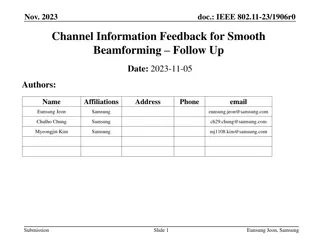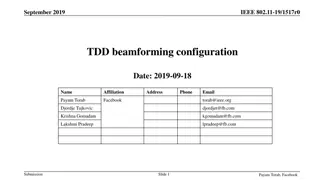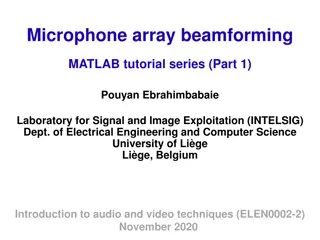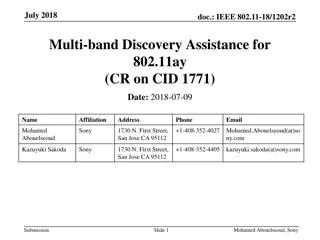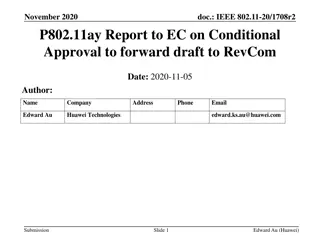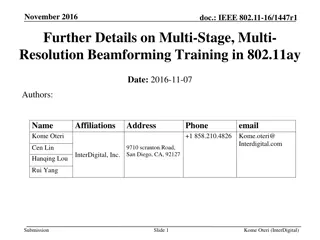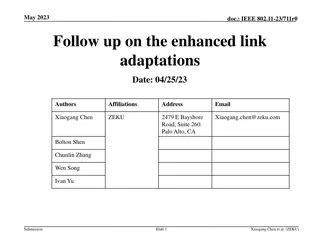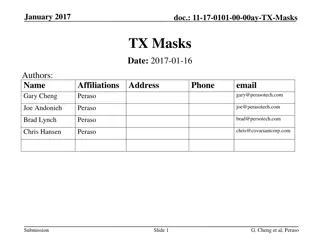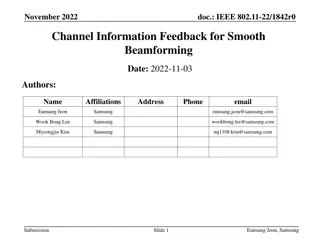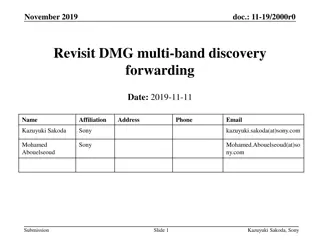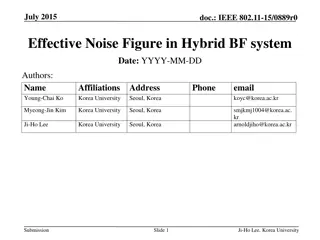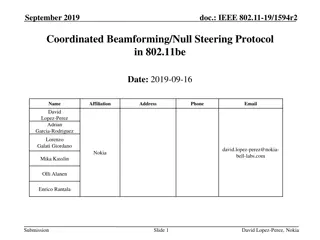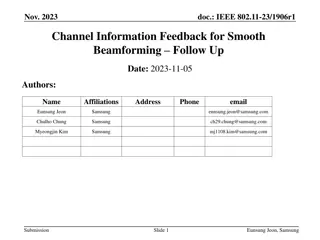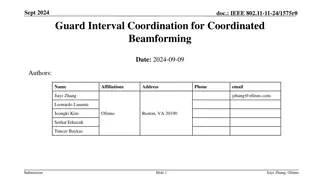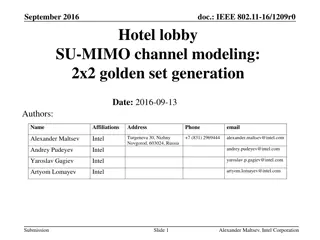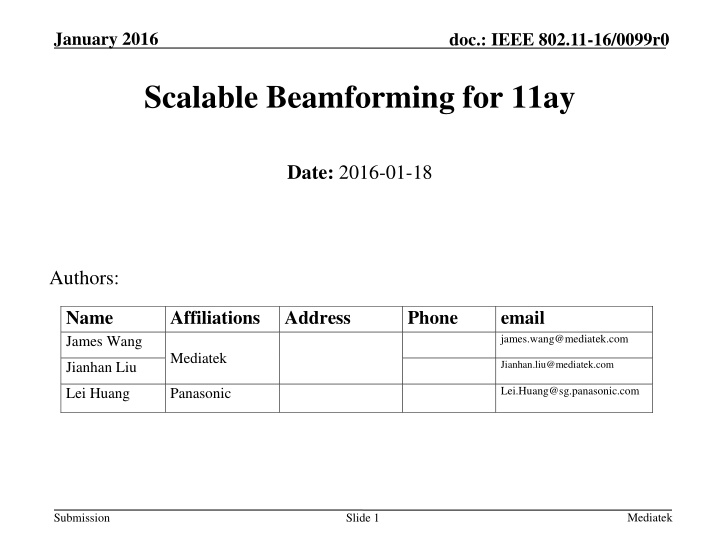
Scalable Beamforming for IEEE 802.11ay: Challenges and Solutions
Explore the scalability issues in beamforming for IEEE 802.11ay technology, focusing on challenges like complexity and interference. Learn about the importance of antenna pattern reciprocity and scalable training methods to address these issues effectively.
Download Presentation

Please find below an Image/Link to download the presentation.
The content on the website is provided AS IS for your information and personal use only. It may not be sold, licensed, or shared on other websites without obtaining consent from the author. If you encounter any issues during the download, it is possible that the publisher has removed the file from their server.
You are allowed to download the files provided on this website for personal or commercial use, subject to the condition that they are used lawfully. All files are the property of their respective owners.
The content on the website is provided AS IS for your information and personal use only. It may not be sold, licensed, or shared on other websites without obtaining consent from the author.
E N D
Presentation Transcript
January 2016 doc.: IEEE 802.11-16/0099r0 Scalable Beamforming for 11ay Date: 2016-01-18 Authors: Name James Wang Affiliations Address Phone email james.wang@mediatek.com Mediatek Jianhan.liu@mediatek.com Jianhan Liu Lei.Huang@sg.panasonic.com Lei Huang Panasonic Mediatek Submission Slide 1
January 2016 doc.: IEEE 802.11-16/0099r0 Scalability 11ad BF training and refinement complexity increases linearly with the number of devices. Difficult to scale to many devices. It is important to be able to support BF training to a large number of devices for many 11ay use cases. WFA No 1 Mainstream use case Wireless Office Docking (proposed new use case) Need to support multiple peripheral devices. WFA No 2 Mainstream use case Mobile Offloading and Multi-Band Operation (MBO) -> Limitations in the number of clients supported by the protocols may prevent effective offloading. Other usage models 4(Data center inter-rack), 5 (VoD, video distribution), 7(front-hauling) and docking all need to deal with a large number of devices. PCP 2 STA STA 3 STA 1 Mediatek Submission 2
January 2016 Latency, Jitter, and Interference doc.: IEEE 802.11-16/0099r0 BF training is needed for establishing the initial communication and subsequent communication, for mobility support and adapting to changing channel conditions, between two devices. Tx Sector sweep during BF training creates interference to neighboring devices BF training is an overhead which creates latency jitter, affecting QoS. Difficult to support multicast. Latency Jitter High Gain/High Rate Link High Gain/High Rate Link BF Training Idle time ( if too long, requires retraining) Mediatek Submission 3
January 2016 doc.: IEEE 802.11-16/0099r0 Antenna Pattern Reciprocity Antenna pattern reciprocity (Antenna pattern reciprocity=1) is defined as a device capable of transmitting and receiving with same antenna pattern, via implicit or explicit calibration or other means. Antenna pattern reciprocal devices provides the following benefits : A antenna pattern reciprocal device can use its knowledge derived the receiver BF training in its TX BF training or vice versa It reduces the overhead of the over-the-air calibration if a device has already been calibrated. Many implementations have antenna pattern reciprocity (shared TX and RX antenna elements) STA 1 Submission 2025/3/19 Mediatek Slide 4
January 2016 doc.: IEEE 802.11-16/0099r0 Scalable Training Scalable training exploits the antenna pattern reciprocity to achieve one-to-multiple STAs antenna training. Initiator engages in BF training with multiple responders simultaneously in which Initiator transmits BF training frames or fields for transmits its transmit antenna/sector and the responder s receiver antenna/sector multiple responders perform receive antennas/sectors training. The responder STAs are required to have antenna pattern reciprocity. The responder STAs do not perform R-TXSS, instead they derive results from their receive BF training utilizing the antenna pattern reciprocity. Since only the initiator transmits training frames, which are received simultaneously by multiple responders. The training time is independent on the number of responders. How the responders feeding back their BF feedbacks is yet to be defined. Mediatek Submission 5
January 2016 doc.: IEEE 802.11-16/0099r0 Applications of BF Training A (I)BSS with a large number of STAs STAs require low latency and jitter PCP/AP does not have the ability to engage in BF training with many STAs PCP/AP advertises BF training schedule and performs periodic scalable training with a large number of STAs. STAs feedback TX sectors to PCP/AP if the TX sectors are different from the last BF training. Mediatek Submission Slide 6
January 2016 doc.: IEEE 802.11-16/0099r0 Why is it Scalable Total number of training fields/frames is [ MAX . sec . sec ] no of TX tors of PCP no of RX tors of STA i STA1 RX sectors STA 1 STA 2 [ i i independent of the number of STAs. STA2 RX sectors MAX sec ] Total number of RX tors of STA i STAn RX sectors STA 1 Mediatek Submission 7
January 2016 doc.: IEEE 802.11-16/0099r0 Scalable Group Training using BRP Scheduled SP Appends TRN-RX training fields for training RX sectors. Allows multiple responders (with reciprocal antenna) to do BF train together. Number of TRN-RX training fields = max(number of RX sectors) of multiple responder STAs Detailed protocol and waveform TBD Mediatek Submission 8
January 2016 doc.: IEEE 802.11-16/0099r0 Proposed BTI BF Training - 1 A PCP/AP can use PLCP header to indicate the RX sector training in the beacon by setting beam tracking request field = Beam Tracking Requested Training length field = max length of all RX sector training STAs Packet type = 0 (BRP-RX) The Duration field of beacon frame is set to the end of BTI. TRN-R PLCP Header BI BTI Duration Mediatek Submission 9
January 2016 doc.: IEEE 802.11-16/0099r0 Proposed BTI BF Training - 2 PCP performs TX Sector training during beacon transmissions (BTI) with all STAs PCP indicates (in PHY header) TRN-R is appended to the beacon or RX sector training. Multiple STAs can perform RX sector training at the end of the beacon. (Use RX sector training to replace TX sector training for devices with antenna pattern reciprocity) Beam Combination Training (TX-RX sector pairing) can also be accomplished simultaneously (for supporting Su-MIMO or Mu-MIMO operation) STAs can feedback TX sector (or selected TX sectors) either unsolicited, when being polled, or when it attempts to initiate a link. Proposed training method is independent of how many STAs being trained simultaneously (scalable to large number of devices). Beacon(s) Beacon(s) RX Sector Training TX Sector Training BTI BTI BI Mediatek Submission
January 2016 DL MU-MIMO BF Training using Scalar BF training doc.: IEEE 802.11-16/0099r0 Scalable training can be used to training multiple STAs with antenna pattern reciprocity in MU- MIMO SLS. Initiator transmits training fields/frames to train PCP/AP s TX antennas/sectors and STAs RX antennas/sectors No R-TXSS is performed by STAs The antenna/sector feedbacks are transmitted by STAs in polling fashion or using random multiple contention. (Note that STAs know which TX antenna/sector to use, initiator uses omni-beam to receive. The ACK can be send using specific antenna/sector based on feedbacks). Note that PCP/AP can train a large number of STAs and down-select STAs for MU-MIMO transmission Scalable beamforming for MU-MIMO BF: PCP/AP transmit sector sweep, in each TX sector transmits training fields for STA RX Mediatek Submission 11
January 2016 doc.: IEEE 802.11-16/0099r0 Conclusions Scalable training utilizes the antenna pattern reciprocity to allow for multiple devices to perform BF training simultaneously. Applications: To train a large number of STAs in BSS simultaneously Efficient MU-MIMO SLS. Detailed waveform and protocol are TBD Mediatek Submission 12
January 2016 doc.: IEEE 802.11-16/0099r0 Straw Poll 1 11ay shall support a mode of operation in which, in single phase, the initiator trains its transmit antennas/sectors and multiple responders train their receive antennas/sectors Yes No Abstain Mediatek Submission 13

